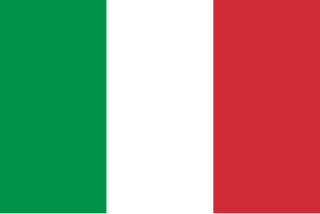Giovanni Antonio Bellinzoni da Pesaro (1415-1477) was an Italian painter of the Renaissance.

Italy, officially the Italian Republic, is a country in Southern Europe. Located in the middle of the Mediterranean Sea, Italy shares open land borders with France, Switzerland, Austria, Slovenia and the enclaved microstates San Marino and Vatican City. Italy covers an area of 301,340 km2 (116,350 sq mi) and has a largely temperate seasonal and Mediterranean climate. With around 61 million inhabitants, it is the fourth-most populous EU member state and the most populous country in Southern Europe.
Bellinzoni was born in Pesaro to the painter Giliolo di Giovanni Bellinzoni. He was taught by his father, and was influenced by Bartolomeo di Tommaso. There is evidence that he worked with his father on a church commission in Gradara (1429), and continued working with him through at least 1437. After his father died, Bellinzoni came into his own right, and was in high demand. He executed frescoes depicting Our Lady of Mercy and Our Lady Enthroned in the Church of the Blessed Sacrament, Saltara. He painted a polyptych found in the collegiate church of Sant'Esuperanzio in Cingoli. He continued working steadily in and around Pesaro until his death in 1477. A biography written about his life won the Salimbeni Prize in 1991 for excellence in the writing of art history on an Italian subject.

Pesaro is a city and comune in the Italian region of Marche, capital of the Province of Pesaro e Urbino, on the Adriatic Sea. According to the 2011 census, its population was 95,011, making it the second most populous city in the Marche, after Ancona. Pesaro was dubbed "Cycling City" by Italian environmentalist association Legambiente in recognition of its extensive network of bicycle paths and promotion of cycling. It is also known as "City of Music" as it is the birthplace of the composer Gioacchino Rossini. In 2015 the Italian Government applied for Pesaro to be declared a "Creative City" in UNESCO's World Heritage sites. In 2017 Pesaro received the European City of Sport award together with Aosta, Cagliari and Vicenza.

Bartolomeo di Tommaso, also known as Bartolomeo da Foligno was an Italian painter of the Umbro-Sienese school.

Gradara is a town and comune in the Province of Pesaro e Urbino (PU), in the region of Marche in central Italy. It is 6 km from Gabicce Mare and Cattolica, 25 km from Rimini, 15 km from Pesaro and 33 km from Urbino.













